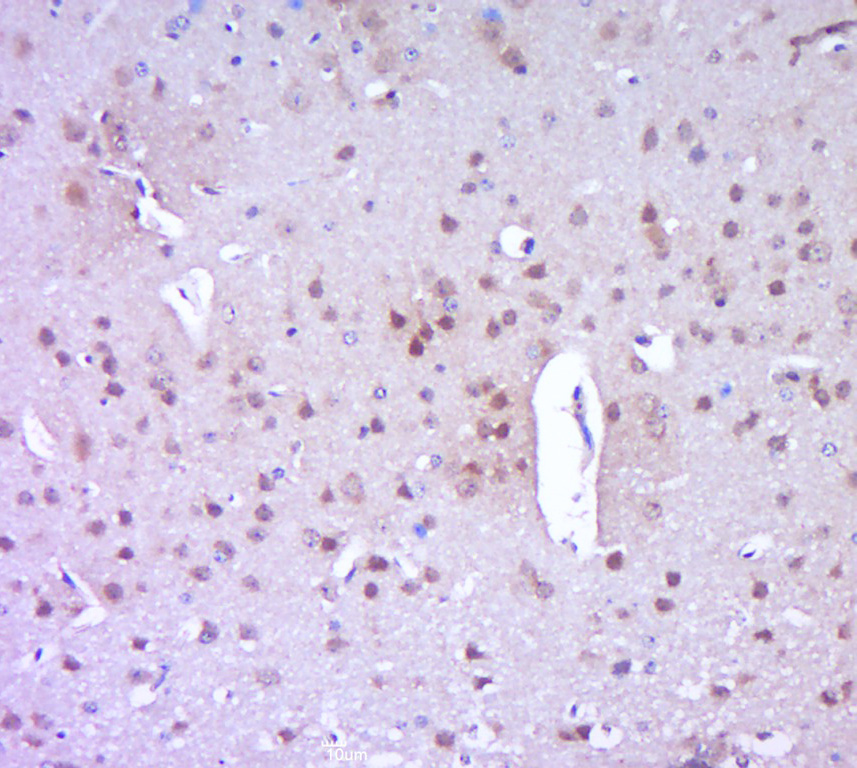PARP antibody
GTX100573
ApplicationsImmunoFluorescence, ImmunoPrecipitation, Western Blot, ChIP Chromatin ImmunoPrecipitation, ImmunoCytoChemistry, ImmunoHistoChemistry, ImmunoHistoChemistry Paraffin
Product group Antibodies
ReactivityHuman, Mouse, Rat
TargetPARP1
Overview
- SupplierGeneTex
- Product NamePARP antibody
- Delivery Days Customer9
- Application Supplier NoteWB: 1:500-1:3000. ICC/IF: 1:100-1:1000. IHC-P: 1:100-1:1000. *Optimal dilutions/concentrations should be determined by the researcher.Not tested in other applications.
- ApplicationsImmunoFluorescence, ImmunoPrecipitation, Western Blot, ChIP Chromatin ImmunoPrecipitation, ImmunoCytoChemistry, ImmunoHistoChemistry, ImmunoHistoChemistry Paraffin
- CertificationResearch Use Only
- ClonalityPolyclonal
- Concentration0.3 mg/ml
- ConjugateUnconjugated
- Gene ID142
- Target namePARP1
- Target descriptionpoly(ADP-ribose) polymerase 1
- Target synonymsADPRT, ADPRT 1, ADPRT1, ARTD1, PARP, PARP-1, PARS, PPOL, Poly-PARP, pADPRT-1, poly [ADP-ribose] polymerase 1, ADP-ribosyltransferase (NAD+; poly (ADP-ribose) polymerase), ADP-ribosyltransferase NAD(+), ADP-ribosyltransferase diphtheria toxin-like 1, DNA ADP-ribosyltransferase PARP1, NAD(+) ADP-ribosyltransferase 1, poly (ADP-ribose) polymerase family, member 1, poly(ADP-ribose) synthetase, poly(ADP-ribosyl)transferase, poly[ADP-ribose] synthase 1, protein poly-ADP-ribosyltransferase PARP1
- HostRabbit
- IsotypeIgG
- Protein IDP09874
- Protein NamePoly [ADP-ribose] polymerase 1
- Scientific DescriptionThis gene encodes a chromatin-associated enzyme, poly(ADP-ribosyl)transferase, which modifies various nuclear proteins by poly(ADP-ribosyl)ation. The modification is dependent on DNA and is involved in the regulation of various important cellular processes such as differentiation, proliferation, and tumor transformation and also in the regulation of the molecular events involved in the recovery of cell from DNA damage. In addition, this enzyme may be the site of mutation in Fanconi anemia, and may participate in the pathophysiology of type I diabetes. [provided by RefSeq, Jul 2008]
- ReactivityHuman, Mouse, Rat
- Storage Instruction-20°C or -80°C,2°C to 8°C
- UNSPSC12352203
References
- Xie E, Ye Z, Wu Y, et al. The triglyceride-glucose index predicts 1-year major adverse cardiovascular events in end-stage renal disease patients with coronary artery disease. Cardiovasc Diabetol. 2023,22(1):292. doi: 10.1186/s12933-023-02028-7Read this paper
- Zhou B, Wang L, Yang S, et al. Rosmarinic acid treatment protects against lethal H1N1 virus-mediated inflammation and lung injury by promoting activation of the h-PGDS-PGD(2)-HO-1 signal axis. Chin Med. 2023,18(1):139. doi: 10.1186/s13020-023-00847-0Read this paper
- Chang HA, Ou Yang RZ, Su JM, et al. YAP nuclear translocation induced by HIF-1α prevents DNA damage under hypoxic conditions. Cell Death Discov. 2023,9(1):385. doi: 10.1038/s41420-023-01687-5Read this paper
- Wang J, Guan P, Chen Y, et al. Cyclovirobuxine D pretreatment ameliorates septic heart injury through mitigation of ferroptosis. Exp Ther Med. 2023,26(2):407. doi: 10.3892/etm.2023.12106Read this paper
- Huang C, Lin ZJ, Chen JC, et al. α-Viniferin-Induced Apoptosis through Downregulation of SIRT1 in Non-Small Cell Lung Cancer Cells. Pharmaceuticals (Basel). 2023,16(5). doi: 10.3390/ph16050727Read this paper
- Fletcher E, Miserlis D, Sorokolet K, et al. Diet-induced obesity augments ischemic myopathy and functional decline in a murine model of peripheral artery disease. Transl Res. 2023,260:17-31. doi: 10.1016/j.trsl.2023.05.002Read this paper
- Wu DD, Dai LJ, Tan HW, et al. Transcriptional upregulation of MAPK15 by NF-κB signaling boosts the efficacy of combination therapy with cisplatin and TNF-α. iScience. 2022,25(12):105459. doi: 10.1016/j.isci.2022.105459Read this paper
- Calcagno G, Ouzren N, Kaminski S, et al. Chronic Hypergravity Induces a Modification of Histone H3 Lysine 27 Trimethylation at TCRβ Locus in Murine Thymocytes. Int J Mol Sci. 2022,23(13). doi: 10.3390/ijms23137133Read this paper
- Tang YC, Chang HH, Chen HH, et al. A novel NRF2/ARE inhibitor gossypol induces cytotoxicity and sensitizes chemotherapy responses in chemo-refractory cancer cells. J Food Drug Anal. 2021,29(4):638-652. doi: 10.38212/2224-6614.3376Read this paper
- Charoensaensuk V, Chen YC, Lin YH, et al. 2,3,5,4'-Tetrahydroxystilbene-2-O-β-glucoside Attenuates Reactive Oxygen Species-Dependent Inflammation and Apoptosis in Porphyromonas gingivalis-Infected Brain Endothelial Cells. Antioxidants (Basel). 2022,11(4). doi: 10.3390/antiox11040740Read this paper





![WB analysis of wild-type (WT) and PARP (cleaved) knockout (KO) HeLa cell extracts using GTX00943 PARP (cleaved) antibody [GT1181]. Dilution : 1:1000 Laoding : 25microg](https://www.genetex.com/upload/website/prouct_img/normal/GTX00943/GTX00943_20200327_WB_1_w_23053121_685.webp)
![FACS analysis of Jurkat cells using GTX83005 PARP antibody [7A10]. Green : PARP Purple : negative control](https://www.genetex.com/upload/website/prouct_img/normal/GTX83005/GTX83005_20170912_FACS_w_23061322_421.webp)